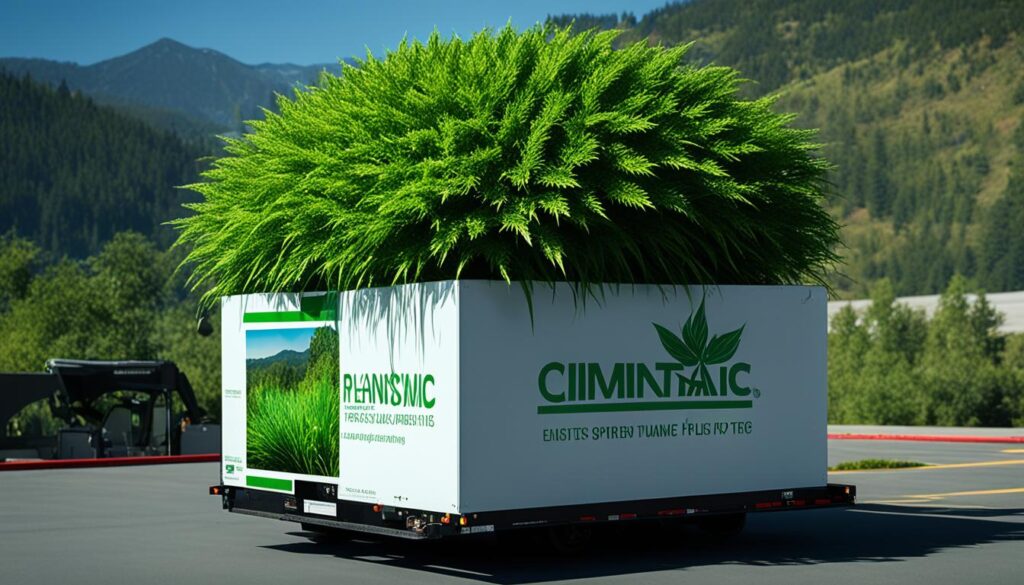Are you planning to move to a new home and worried about transporting your precious plants? No need to fret! With the right knowledge and best practices, you can effectively transport your plants to your new location. In this section, we will provide you with essential tips and tricks on how to transport plants.
Key Takeaways:
- Properly prepare your plants for transportation
- Choose the right transportation method that suits your plant’s needs
- Ensure your plants get enough light and water during transit
- Avoid packing your plants too tightly to prevent damage
- Gradually acclimate your plants to their new environment after arrival
Preparing Your Plants for Transportation
When it comes to moving plants to a new location, preparation is key. Follow these steps to ensure that your plants are safely transported without causing any damage:
- Prune your plants: Trim any dead or damaged leaves, stems or flowers from your plants before the move. This will help to reduce the overall weight of your plants and prevent potential damage during transportation.
- Re-pot your plants: If your plants are in old or damaged pots, consider re-potting them a few weeks before the move. Make sure to use the appropriate soil and pot size for each plant, and let the new soil settle for a few days before the move.
- Water your plants: A few days prior to the move, make sure to water your plants thoroughly. This will provide them with enough moisture for the journey, without causing excess weight or risk of spillage during transportation.
- Protect your plants during transportation: Wrap your plants in newspaper or cloth to protect them from potential damage during transportation. For larger plants, consider wrapping them in plastic sheets or blankets to prevent them from moving around in their containers.
By taking the time to properly prepare your plants for transportation, you can ensure that they arrive safely at their new location, ready to thrive in their new environment.
Best Practices for Transporting Plants

Transporting your plants to your new location can be a challenging task, especially when you have to move them long distances. Nonetheless, with proper planning and execution, you can ensure that your plants arrive safely and thrive in their new home. Here are some plant relocation techniques and transport tips to help you along the way.
1. Choose Appropriate Containers
The first step in transporting plants is to select appropriate containers. Make sure that your plants are in sturdy containers and have been potted in fresh soil several weeks before the move. Using plastic containers is more convenient, especially for long-distance transportation, as they are lightweight and less likely to break.
2. Water Your Plants
Before the move, water your plants thoroughly but do not saturate the soil to avoid root rot. For long-distance moves, you may want to consider lining the container with plastic and adding a layer of damp sphagnum moss to keep the plants hydrated during the journey.
3. Provide Proper Ventilation
During transportation, proper ventilation is essential for your plants’ survival. Open the windows or turn on the air conditioner in your vehicle to keep the air flowing. If you’re transporting plants in a closed truck, make sure that there’s enough ventilation to avoid suffocation.
| Transportation Method | Pros | Cons |
|---|---|---|
| Car | Convenient for short distances | Limited space and may get hot |
| Truck | Good for long distances and large quantities of plants | Wind damage and limited accessibility |
| Shipping | Good for long distances and international moves | Expensive and not suitable for delicate plants |
4. Avoid Extreme Temperatures
Plants are sensitive to extreme temperatures, so it’s important to avoid exposing them to hot or cold weather during transportation. If you’re moving plants during the summer or winter, make sure to keep them in a climate-controlled environment. Wrap plants in blankets or towels to minimize temperature fluctuations.
5. Gradual Acclimation
After arrival, gradually acclimate your plants to their new environment. Place them in a shady location for a few days and gradually move them to a sunnier spot. Make sure to water them regularly and monitor them for any signs of stress.
With these plant shipping advice tips, you can transport your plants with confidence, knowing that they will arrive safely at their new home. Remember to choose appropriate containers, provide proper ventilation, avoid extreme temperatures, and gradually acclimate your plants to their new environment. Before you know it, your plants will be flourishing in their new space.
Conclusion
Congratulations on successfully learning how to transport your plants to your new home! By following the tips and best practices provided in this article, you can ensure that your greenery arrives at its destination in perfect condition.
Remember to plan ahead, providing your plants with proper care during transport, and gradually acclimating them to their new environment upon arrival. Taking these necessary steps can help your plants thrive in their new home.
Don’t forget to stay patient and attentive during the entire transportation process. You may encounter some unexpected bumps, but with the knowledge gained from this article, you can handle them with ease.
Happy moving and safe travels!
FAQ
How can I safely transport my plants?
To safely transport your plants, there are a few key steps you can follow. First, make sure to adequately prepare your plants for transportation by pruning them if necessary, removing any dead leaves or flowers, and transplanting them into lightweight containers. It’s also important to protect delicate foliage with newspaper or bubble wrap. When transporting your plants, secure them in your vehicle or moving truck to prevent them from shifting or toppling over. Finally, avoid exposing your plants to extreme temperatures during transportation by keeping them in a climate-controlled space if possible.
How do I prepare my plants for transportation?
Before you move your plants, it’s crucial to prepare them properly to minimize any potential damage. Start by watering your plants a day or two before the move, allowing their soil to absorb the moisture. This will help prevent dehydration during transportation. Next, gently prune your plants to remove any dead or excessive growth. If transferring your plants to smaller containers, choose lightweight options that provide adequate drainage. Finally, secure the foliage of delicate plants with newspaper or bubble wrap to protect them from damage.
What are the best practices for transporting plants over long distances?
Transporting plants over long distances requires some extra care and planning. First, choose the appropriate time of year to transport your plants, preferably during mild weather conditions when temperature extremes are less likely. Before the move, acclimate your plants to their new environment by gradually exposing them to similar conditions. When packing your plants, use sturdy boxes or containers to prevent any crushing or shifting. Consider using packing materials such as newspaper or plastic wrap to provide extra cushioning and support. During the journey, monitor the temperature and humidity levels to ensure your plants stay comfortable.
How can I move my plants to a new location without damaging them?
Moving plants to a new location without causing damage requires careful handling and preparation. Start by assessing the specific needs of your plants, including their light and temperature requirements, and choose a new location that can accommodate these needs. Before the move, prepare your plants by watering them appropriately and gently pruning any excess growth. When transporting the plants, protect their foliage with newspaper or bubble wrap to prevent it from getting bruised or broken. Secure the plants in your vehicle or moving truck to prevent shifting or toppling during transit. After arrival, gradually acclimate your plants to their new environment by exposing them to increasing amounts of light and adjusting their watering schedule.




